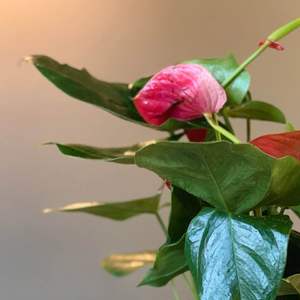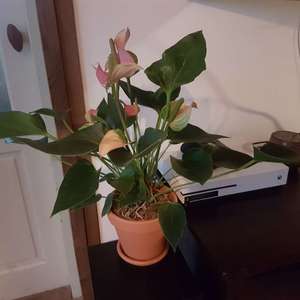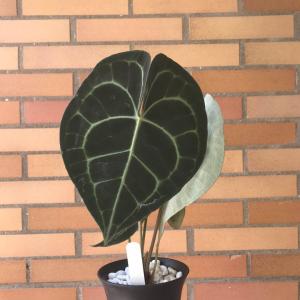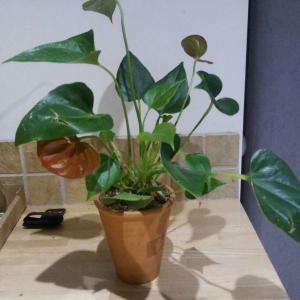文章
Miss Chen
2021年08月10日

Anthurium is a genus of around 1,000 species of perennial plants native to Central America, northern South America, and the Caribbean. While they can be grown outdoors in the garden in warm climates, anthurium is more often grown as houseplants by enthusiasts willing to put forth the effort for a plant that can be fussy. Some species are highly prized for their bright, exotic flowers, while others are grown mostly for their foliage.
The flowering varieties of these plants are distinctive for their multicolored spathes and red or yellow tail-like flower spikes. Other varieties feature large-leaved, deeply veined foliage. Many anthuriums are climbers and all need high humidity and warmth to thrive. They tend to thrive in greenhouses, and no type of anthurium is particularly well-suited for indoor, domestic living without a lot of attention and care.
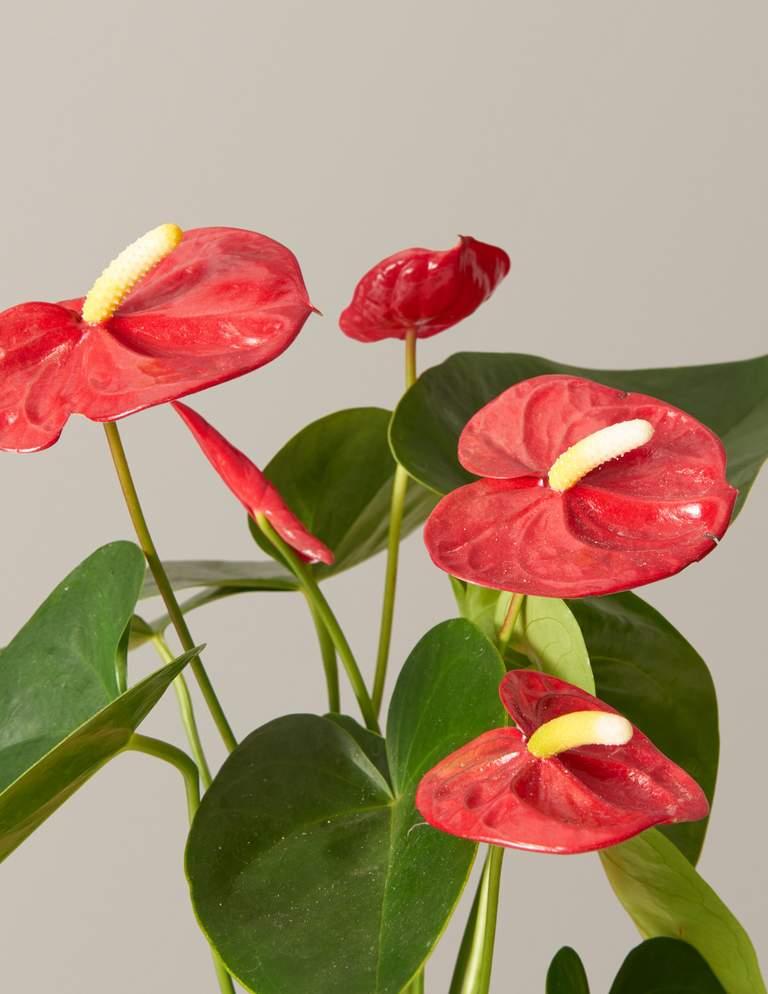
Botanical Name Anthurnium spp.
Common Names Anthurium, tailflower, flamingo flower, laceleaf
Plant Type Herbaceous perennial
Mature Size 12 to 18 inches, 9- to 12-inch spread
Sun Exposure Bright indirect light
Soil Type Coarse, moist potting mix
Soil pH 5.5 to 6.5 (slightly acidic)
Bloom Time Flowers freely
Bloom Color Red, pink, or white, with contrasting spadex
Hardiness Zones 11 to 12
Native Area Central America, northern South America, Caribbean.
Anthurium Plant Care
Anthurium plants thrive in bright, indirect light. They do not like exposure to direct sunlight, except in the winter months or in plants that have been carefully acclimated. Wild anthuriums generally live in temperatures at or above 60 degrees Fahrenheit and the foliage types prefer temperatures even warmer. If temperatures dip below this level, the plant will suffer.
Potted anthuriums prefer a rich but well-draining potting mix that should be kept moist but not wet. A potting mix tailored for orchids, with a few handfuls of sand and a few handfuls of peat moss mixed in, is ideal.
In natural settings, many anthurium plants are "epiphytic"—they grow on other plants instead of in soil. If your plant fails to support itself, give it a stake or small trellis to climb on.
Repotting should be done whenever the plant fills up its pot with roots.This can occur every year or two, when you see "air roots" begin to extend up above the soil level. This is a sign that the plant can be repotted, which is also a good time to propagate new plants.
Light
Indoors or out, anthuriums grow best in bright, indirect light. Avoid direct sun, which can burn the leaves.
Soil
Anthuriums prefer a coarse, well-draining potting. An orchid mix with additional sand and peat moss mixed in, makes a perfect potting mix for anthuriums.
Water
The soil should be kept slightly moist and never allowed to dry out completely. Setting the pot in a tray of water-filled gravel will help the plant drain and also help keep humidity levels high. Allow the top of the soil to dry out to the touch before watering again.
Temperature and Humidity
All species of anthurium are native tropical plants and mimicking those conditions will give you the best chances for success. This plant prefers high humidity and temperatures between 65 and 85 degrees Fahrenheit. These plants can be grown outside only in zones 11 to 12, and will likely perish at temperatures 40 degrees or less.
In dry climates—or during dry winter months—mist the plant daily to keep humidity levels high. You may find it necessary to run a humidifier constantly during dry months.
Fertilizer
It is safe and recommended to use liquid fertilizer throughout the growing period. Use a fertilizer high in phosphorus, and dilute it to half strength to feed the plants every two weeks or so.
Propagating Anthuriums
An easy way to create new anthuriums is by cutting off the "air roots" that grow up above the soil level in the pot, dipping these root pieces in rooting hormone, and burying them in a new pot with fresh potting mix. Roots will start to send up stems and leaves within four to six weeks.
Anthuriums can also be propagated from cuttings. Select a stem at least 6 inches long with two or three sets of leaves. Dip the cut end of the stem in rooting hormone, then bury it in potting mix up to the first set of leaves. Water the cutting thoroughly when you plant it, then whenever the soil becomes dry. Mist the cutting each week to provide humidity. The cutting should develop roots within four to six weeks, and new growth shoots will soon follow.
Potting and Repotting
When an anthurium fills up its pot with roots and begins to send up plentiful air roots, it is time to repot. Normally, this is necessary every two years or so. Transfer the plant to a pot that only slightly larger than the old one—no more than 2 inches larger. Fill the pot only about 1/3 full of potting mix, then set the plant onto the soil and lightly pack additional soil around the base, up to the level the plant was buried in its old pot.
As new air roots form above the soil over the following weeks, lightly pack additional potting mix around the exposed roots.

Varieties of Anthurium
Common varieties sold as house plants include:
A. andreanum: These feature heart-shaped leaves that grow up to 1 foot, with flowers available in red, white, pink, and variegated colors. They are distinguished by a straight flower spike.
A. scherzerianum: The most forgiving of anthuriums, it features a curling orange flower spike and the leaves are arrow-shaped.
Anthuriums are collector's plants, and many of the most magnificent varieties are rarely found outside of greenhouses and botanical gardens. Other, less common species to consider include:
A. crystallinum: These have deep green, velvety leaves with pronounced white ribs. The leaves grow up to 2 feet across.
A. faustinomirandae: A monster-sized plant with cardboard-stiff leaves that grow up to 5 feet long. This is almost exclusively a greenhouse plant.
A. crystallinum: These have deep green, velvety leaves with pronounced white ribs. The leaves grow up to 2 feet across.
A. faustinomirandae: A monster-sized plant with cardboard-stiff leaves that grow up to 5 feet long. This is almost exclusively a greenhouse plant.
Common Pests/ Diseases
These plants are subject to some of the same pests that commonly affect most houseplants: mealybugs, spider mites, whitefly, and scale. Horticultural oils and soaps can be used to treat these.
If dry or drafty locations, the foliage on anthuriums may scorch. In rare cases, fungal rots, blights, or leaf spots may occur.
The flowering varieties of these plants are distinctive for their multicolored spathes and red or yellow tail-like flower spikes. Other varieties feature large-leaved, deeply veined foliage. Many anthuriums are climbers and all need high humidity and warmth to thrive. They tend to thrive in greenhouses, and no type of anthurium is particularly well-suited for indoor, domestic living without a lot of attention and care.

Botanical Name Anthurnium spp.
Common Names Anthurium, tailflower, flamingo flower, laceleaf
Plant Type Herbaceous perennial
Mature Size 12 to 18 inches, 9- to 12-inch spread
Sun Exposure Bright indirect light
Soil Type Coarse, moist potting mix
Soil pH 5.5 to 6.5 (slightly acidic)
Bloom Time Flowers freely
Bloom Color Red, pink, or white, with contrasting spadex
Hardiness Zones 11 to 12
Native Area Central America, northern South America, Caribbean.
Anthurium Plant Care
Anthurium plants thrive in bright, indirect light. They do not like exposure to direct sunlight, except in the winter months or in plants that have been carefully acclimated. Wild anthuriums generally live in temperatures at or above 60 degrees Fahrenheit and the foliage types prefer temperatures even warmer. If temperatures dip below this level, the plant will suffer.
Potted anthuriums prefer a rich but well-draining potting mix that should be kept moist but not wet. A potting mix tailored for orchids, with a few handfuls of sand and a few handfuls of peat moss mixed in, is ideal.
In natural settings, many anthurium plants are "epiphytic"—they grow on other plants instead of in soil. If your plant fails to support itself, give it a stake or small trellis to climb on.
Repotting should be done whenever the plant fills up its pot with roots.This can occur every year or two, when you see "air roots" begin to extend up above the soil level. This is a sign that the plant can be repotted, which is also a good time to propagate new plants.
Light
Indoors or out, anthuriums grow best in bright, indirect light. Avoid direct sun, which can burn the leaves.
Soil
Anthuriums prefer a coarse, well-draining potting. An orchid mix with additional sand and peat moss mixed in, makes a perfect potting mix for anthuriums.
Water
The soil should be kept slightly moist and never allowed to dry out completely. Setting the pot in a tray of water-filled gravel will help the plant drain and also help keep humidity levels high. Allow the top of the soil to dry out to the touch before watering again.
Temperature and Humidity
All species of anthurium are native tropical plants and mimicking those conditions will give you the best chances for success. This plant prefers high humidity and temperatures between 65 and 85 degrees Fahrenheit. These plants can be grown outside only in zones 11 to 12, and will likely perish at temperatures 40 degrees or less.
In dry climates—or during dry winter months—mist the plant daily to keep humidity levels high. You may find it necessary to run a humidifier constantly during dry months.
Fertilizer
It is safe and recommended to use liquid fertilizer throughout the growing period. Use a fertilizer high in phosphorus, and dilute it to half strength to feed the plants every two weeks or so.
Propagating Anthuriums
An easy way to create new anthuriums is by cutting off the "air roots" that grow up above the soil level in the pot, dipping these root pieces in rooting hormone, and burying them in a new pot with fresh potting mix. Roots will start to send up stems and leaves within four to six weeks.
Anthuriums can also be propagated from cuttings. Select a stem at least 6 inches long with two or three sets of leaves. Dip the cut end of the stem in rooting hormone, then bury it in potting mix up to the first set of leaves. Water the cutting thoroughly when you plant it, then whenever the soil becomes dry. Mist the cutting each week to provide humidity. The cutting should develop roots within four to six weeks, and new growth shoots will soon follow.
Potting and Repotting
When an anthurium fills up its pot with roots and begins to send up plentiful air roots, it is time to repot. Normally, this is necessary every two years or so. Transfer the plant to a pot that only slightly larger than the old one—no more than 2 inches larger. Fill the pot only about 1/3 full of potting mix, then set the plant onto the soil and lightly pack additional soil around the base, up to the level the plant was buried in its old pot.
As new air roots form above the soil over the following weeks, lightly pack additional potting mix around the exposed roots.

Varieties of Anthurium
Common varieties sold as house plants include:
A. andreanum: These feature heart-shaped leaves that grow up to 1 foot, with flowers available in red, white, pink, and variegated colors. They are distinguished by a straight flower spike.
A. scherzerianum: The most forgiving of anthuriums, it features a curling orange flower spike and the leaves are arrow-shaped.
Anthuriums are collector's plants, and many of the most magnificent varieties are rarely found outside of greenhouses and botanical gardens. Other, less common species to consider include:
A. crystallinum: These have deep green, velvety leaves with pronounced white ribs. The leaves grow up to 2 feet across.
A. faustinomirandae: A monster-sized plant with cardboard-stiff leaves that grow up to 5 feet long. This is almost exclusively a greenhouse plant.
A. crystallinum: These have deep green, velvety leaves with pronounced white ribs. The leaves grow up to 2 feet across.
A. faustinomirandae: A monster-sized plant with cardboard-stiff leaves that grow up to 5 feet long. This is almost exclusively a greenhouse plant.
Common Pests/ Diseases
These plants are subject to some of the same pests that commonly affect most houseplants: mealybugs, spider mites, whitefly, and scale. Horticultural oils and soaps can be used to treat these.
If dry or drafty locations, the foliage on anthuriums may scorch. In rare cases, fungal rots, blights, or leaf spots may occur.
0
0
文章
Miss Chen
2018年08月02日

Anthurium is a genus of tropical flowers native to the West Indies, Mexico and South America. They are commonly grown in warm climates such as Hawaii and southern Florida, as well as indoors and in greenhouses. They are noted for their large, colorful flowers and long spathes and are often used in bouquets and floral arrangements. Anthuriums can be propagated from seed and through division or cuttings. Division is the fastest method to propagate anthuriums and can be done by the average home gardener.

Step 1
Examine the plant and look for offshoots that emerge from the ground near the main stem. The shoots grow from the roots of the main plant. In one year, up to 15 can appear from a healthy anthurium.
Step 2
Dig up healthy-looking offshoots. Using sharp garden clippers, cut the roots about 4 to 5 inches deep to remove the offshoots from the mother plant. These aerial roots are necessary for successful propagation.

Step 3
Replant the divided shoots in 4- to 6-inch pots that are filled with rich, organic potting soil. Keep the soil moist and place the pots in a humid location with partial sun.

Step 1
Examine the plant and look for offshoots that emerge from the ground near the main stem. The shoots grow from the roots of the main plant. In one year, up to 15 can appear from a healthy anthurium.
Step 2
Dig up healthy-looking offshoots. Using sharp garden clippers, cut the roots about 4 to 5 inches deep to remove the offshoots from the mother plant. These aerial roots are necessary for successful propagation.

Step 3
Replant the divided shoots in 4- to 6-inch pots that are filled with rich, organic potting soil. Keep the soil moist and place the pots in a humid location with partial sun.
0
0



